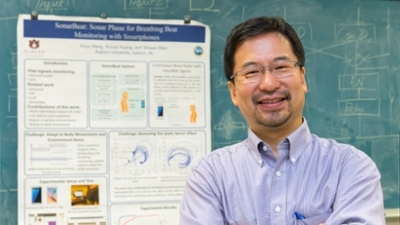Auburn researchers recognized for ‘SonarBeat’ vital sign monitoring system at international conference
Two graduate students and their faculty adviser from Auburn University's Department of Electrical and Computer Engineering and the Wireless Engineering Research and Education Center were recognized recently for their demonstration of the 'SonarBeat' vital sign monitoring system at an international conference hosted by the Institute of Electrical and Electronics Engineers.
Xuyu Wang, Runze Huang and Shiwen Mao earned the Best Demo Award for their project titled "SonarBeat: Sonar Phase for Breathing Beat Monitoring with Smartphones." The technology, which has future applications in health care, disaster recovery and even drowsy driving detection, is a contact-free system, which uses the transmittal of wireless signals to monitor respiration and heart rates.
"We have been working on this system for over a year," said Shiwen Mao, Samuel Ginn professor and director of the Wireless Engineering Research and Education Center. "We use a Wi-Fi signal and acoustic signal to detect respiration and heart rates of a patient. Rather than using sensors that attach to the chest or clip to your fingertips, the technology is contact-free, low-cost, easy to deploy and suitable for long-term monitoring of a patient's conditions."
The system uses a wireless transmitter via smartphone or laptop to transmit signals into open space.
"The signal hits on the chest of the patient – there is a chest movement induced by breathing and the movements of the heart – and the wireless signal changes," he said. "Those chest movements change the feature characteristics of the signal, and we have a wireless receiver which picks up the reflected signal to detect the small variations induced by the movements. We are then able to make accurate estimates of respiration and heart rates."
The smartphone app-based system has been tested in a living room, an office and even a crowded movie theater. The next step is to pursue collaborations for testing the technology with researchers in industry or medical schools.
Mao said the technology will eventually be available for use in the home to assist those who are living alone, without the necessity of specialized or expensive equipment.
"We can use what's monitored to detect an issue or to compare with certain features that can indicate certain types of disease," he said. "By comparing the data, we can detect anomalies and send alarms to the doctor or directly to the patient. In addition, the wireless system's signal is able to penetrate obstacles and could be used to locate survivors in the aftermath of a disaster or to detect breathing patterns and sound an alarm to wake a tired driver."
The award-winning demo was held at the Institute of Electrical and Electronics Engineers International Conference on Sensing, Communication and Networking, or IEEE SECON. The conference focuses on novel communication technologies and emerging applications and services involving mobile sensing and communication, and ubiquitous and pervasive computing.
Media Contact: , nelsoc4@auburn.edu, 334.844.3447
shiwen-mao

